Gothic_novel哥特式小说(英文)
英美文学名词解释Z
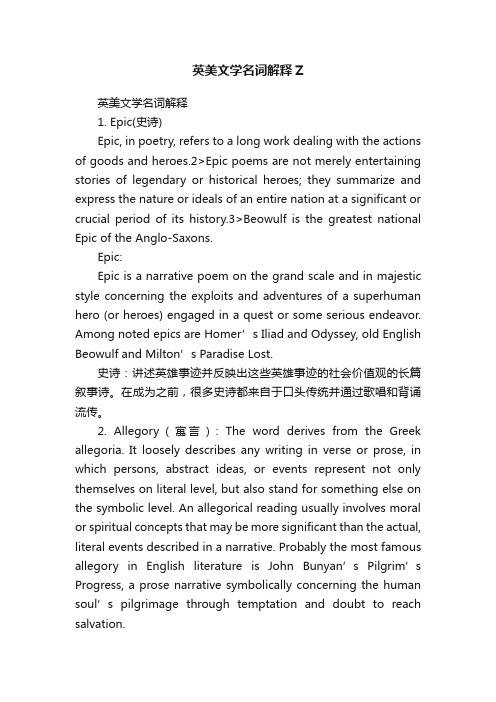
英美文学名词解释Z英美文学名词解释1. Epic(史诗)Epic, in poetry, refers to a long work dealing with the actions of goods and heroes.2>Epic poems are not merely entertaining stories of legendary or historical heroes; they summarize and express the nature or ideals of an entire nation at a significant or crucial period of its history.3>Beowulf is the greatest national Epic of the Anglo-Saxons.Epic:Epic is a narrative poem on the grand scale and in majestic style concerning the exploits and adventures of a superhuman hero (or heroes) engaged in a quest or some serious endeavor. Among noted epics are Homer’s Iliad and Odyssey, old English Beowulf and Milton’s Paradise Lost.史诗:讲述英雄事迹并反映出这些英雄事迹的社会价值观的长篇叙事诗。
在成为之前,很多史诗都来自于口头传统并通过歌唱和背诵流传。
2. Allegory(寓言): The word derives from the Greek allegoria. It loosely describes any writing in verse or prose, in which persons, abstract ideas, or events represent not only themselves on literal level, but also stand for something else on the symbolic level. An allegorical reading usually involves moral or spiritual concepts that may be more significant than the actual, literal events described in a narrative. Probably the most famous allegory in English literature is Joh n Bunyan’s Pilgrim’s Progress, a prose narrative symbolically concerning the human soul’s pilgrimage through temptation and doubt to reach salvation.3. Sonnet(十四行诗)A sonnet is a fourteen-line poem in iambic pentameter with a carefully patterned rhyme scheme.It is a lyric poem of 14 lines with a formal or recited and characterized by its presentation of a dramatic or exciting episode in simple narrative form.2>it is one of the most conventional and influential forms of poetry in Europe.3>S hakespeare’s so nnets are well-known. The famous poets are Shakespeare, Sidney, Daniel, Spenser and so on.4. Humanism(人文主义)Humanism is the essence of the Renaissance.2> it emphasizes the dignity of human beings and the importance of the present life. Humanists voiced their beliefs that man was the center of the universe and man did not only have the right to enjoy the beauty of the present life, but had the ability to perfect himself and to perform wonders.In Greek and Roman civilization, man is the measure of all things. Contrary to the medieval philosophy, the humanists believed that it was justified to praise human nature and that human beings are glorious creatures capable of development in the direction of perfection. The world was theirs not to dislike but to question, explore and enjoy. Thus, by emphasizing the value of human beings and the important of the present life, the emphasized that man not only have the right to enjoy the beauty of this life, but have the ability to perfect themselves and create wonders.5. The angel in the house(屋中天使)The Angel in the House is a narrative poem by Coventry Patmore, first published in 1854 and expanded until 1862. Although largely ignored upon publication, it becameenormously popular during the later 19th century and its influence continued well into the twentieth. The poem was an idealized account of Patmore's courtship of his first wife, Emily, whom he believed to be the perfect woman. Angel in the house are usually immensely sympathetic, immensely charming, utterly unselfish.6. Byronic Hero(拜伦式英雄)Byronic hero refers to a proud, mysterious rebel figure of noble origin.2> with immense superiority in his passions and powers, this Byronic Hero would carry on his shoulders the burden of righting all the wrongs in a corrupt and evil society, and would rise single-handedly against any kind of tyrannical rules either in government, in religion, or in moral principles with unconquerable wills and inexhaustible energies. The conflict is usually one of rebellious individuals against outworn social systems and convention. Such a hero appears first in Childe Harold’s pilgrimage and then further developed in later works such as Manfred and Don Juan.3> Byron’s chief contribution to English literature is his creation of the “Byronic Hero”The Byronic hero is an idealized but flawed character exemplified in the life and writings of Lord Byron, characterized by his ex-lover Lady Caroline Lamb as being "mad, bad, and dangerous to know".[1] The Byronic hero first appears in Byron's semi-autobiographical epic narrative poem Childe Harold's Pilgrimage (1812-18).7. Gothic novel(哥特式小说)Gothic novel is a type of romance very popular late in the 18th century and at the beginning of the 19th century.2> Gothic novel emphasizes things which are grotesque, violent, mysterious, supernatural, desolate and horrifying.3> Gothic,originall y in the sense of “medi, not classical”. With its descriptions of the dark, irrational side of human nature, Gothic novel has exerted a great influence over the writers of the Romantic period.Gothic Fiction: Gothic Fiction means a style of writing popular in the late 18th century which produced stories set in lonely frightening places. Gothic Fiction invariably exploits ghosts and monsters and setting such as castles, dungeons and graveyards, which imparts a suitably sinister and terrifying atmosphere. The Gothic Fiction have opened up to later fictions the dark, irrational side of human nature —the savage egoism, the perverse impulses, and the nightmarish terror that lie beneath the controlled and ordered surface of the conscious mind. Gothic Fiction has exerted significant influence on the literature of later generations. The first Gothic Fiction is Horace Walpole’s The Castle of Otranto.8. Naturalism(自然主义)Naturalism is a literary movement related to and sometimes described as an extreme form of realism but which may be more appropriately considered as a parallel to philosophic Naturalism.2) as a more deliberate kind of realism Naturalism usually involves a view of human beings as passive victims of natural forces and social environment. In Naturalism a more documentary-like approach is in evidence, with a great stress on how environment and heredity shape people. 3) As a literary movement, Naturalism was initiated in France. 4) Naturalist fiction aspired to a sociological objectivity, offering detailed and fully researched investigations into unexplored concerns of modern society. One of those significant works of naturalism is Theodore Dreiser’s Sister Carrie.9. The Graveyard School(墓地派诗歌)The Graveyard School refers to a school of poets of the 18th century whose poems are mostly devoted to a sentimental lamentation or meditation on life. Past and present, with death and graveyard as themes.2>Thomas Gray is considered to be the leading figure of this school and hisElegy written in a country churchyard is its most representative work.10. Metaphysical poets(玄学派诗人)It is the name given to a diverse group of 17th century English poets whose work is notable for its ingenious use of intellectual and theological concepts in surprising conceits, strange paradoxes and far-fetched imagery. The leading Metaphysical poet was John Donne, whose colloquial, argumentative abruptness of rhythm and tone distinguishes his style from the conventions of Elizabethan love lyrics.Metaphysical poetry(玄学派诗歌)Metaphysical poetry is commonly used to name the work of the 17th century writers who wrote under the influence of John Donne.2>with a rebellious spirit, the Metaphysical poets tried to break away from the conventional fashion of the Elizabethan love poetry.3>the diction is simple as compared with that of the Elizabethan or the Neoclassical periods, and echoes the words and cadences of common speech.4>the imagery is drawn from actual life.Metaphysical poetry: The poetry of John Donne and other 17th century poets who wrote in a similar style. Metaphysical poetry is characterized by verbal wit and excess, ingenious structure; irregular meter, colloquial language, elaborate imagery, and a drawing together of dissimilar ideas. 玄学诗:约翰?多恩的诗或17世纪其他诗人写的相同风格的诗。
英国文学专业术语翻译
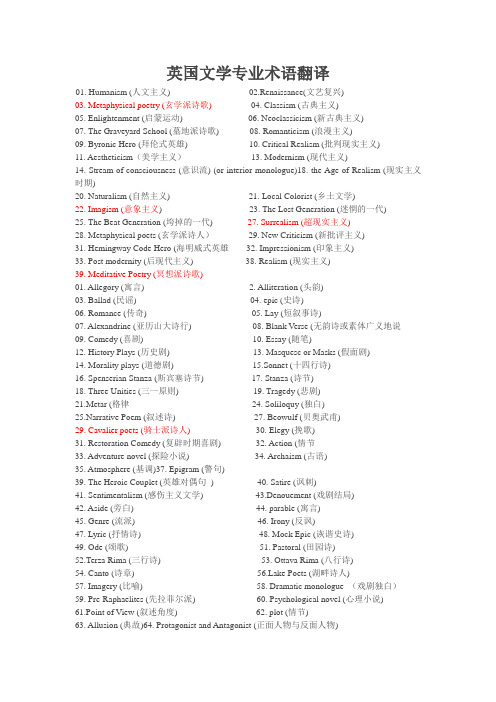
英国文学专业术语翻译01. Humanism (人文主义) 02.Renaissance(文艺复兴)03. Metaphysical poetry (玄学派诗歌)04. Classism (古典主义)05. Enlightenment (启蒙运动) 06. Neoclassicism (新古典主义)07. The Graveyard School (墓地派诗歌) 08. Romanticism (浪漫主义)09. Byronic Hero (拜伦式英雄) 10. Critical Realism (批判现实主义)11. Aestheticism(美学主义)13. Modernism (现代主义)14. Stream of consciousness (意识流) (or interior monologue)18. the Age of Realism (现实主义时期)20. Naturalism (自然主义) 21. Local Colorist (乡土文学)22. Imagism (意象主义) 23. The Lost Generation (迷惘的一代)25. The Beat Generation (垮掉的一代) 27. Surrealism (超现实主义)28. Metaphysical poets (玄学派诗人)29. New Criticism (新批评主义)31. Hemingway Code Hero (海明威式英雄32. Impressionism (印象主义)33. Post modernity (后现代主义) 38. Realism (现实主义)39. Meditative Poetry (冥想派诗歌)01. Allegory (寓言) 2. Alliteration (头韵)03. Ballad (民谣) 04. epic (史诗)06. Romance (传奇) 05. Lay (短叙事诗)07. Alexandrine (亚历山大诗行) 08. Blank Verse (无韵诗或素体广义地说09. Comedy (喜剧) 10. Essay (随笔)12. History Plays (历史剧) 13. Masquesc or Masks (假面剧)14. Morality plays (道德剧) 15.Sonnet (十四行诗)16. Spenserian Stanza (斯宾塞诗节) 17. Stanza (诗节)18. Three Unities (三一原则) 19. Tragedy (悲剧)21.Metar (格律24. Soliloquy (独白)25.Narrative Poem (叙述诗) 27. Beowulf (贝奥武甫)29. Cavalier poets (骑士派诗人) 30. Elegy (挽歌)31. Restoration Comedy (复辟时期喜剧) 32. Action (情节33. Adventure novel (探险小说) 34. Archaism (古语)35. Atmosphere (基调)37. Epigram (警句)39. The Heroic Couplet (英雄对偶句) 40. Satire (讽刺)41. Sentimentalism (感伤主义文学) 43.Denouement (戏剧结局)42. Aside (旁白) 44. parable (寓言)45. Genre (流派) 46. Irony (反讽)47. Lyric (抒情诗) 48. Mock Epic (诙谐史诗)49. Ode (颂歌) 51. Pastoral (田园诗)52.Terza Rima (三行诗) 53. Ottava Rima (八行诗)54. Canto (诗章) ke Poets (湖畔诗人)57. Imagery (比喻) 58. Dramatic monologue (戏剧独白)59. Pre-Raphaelites (先拉菲尔派) 60. Psychological novel (心理小说)61.Point of View (叙述角度) 62. plot (情节)63. Allusion (典故)64. Protagonist and Antagonist (正面人物与反面人物)65. Flashback (倒叙) P133 66. Narration67. Ambiguity 69. Symbolism (象征主义)72. Existentialism (存在主义) 73. Anti-hero (反面人物)74 . Round Character (丰满的人物) 75. Flat character (平淡的人物)76. Oedipus complex (俄狄浦斯情结/ 蛮母厌父情结)77.omniscience (无所不知的)78. Poetry (诗歌) 79. Rhyme (押韵)80. Iambic pentameter (五音步诗) 81. Rhyme royal82. Shakespearean sonnet (莎士比亚十四行诗) 83. Italian or petranrchan sonnet(意大利十四行诗)85. Poetic license (诗的破格) 86. Epiphany (主显节)87. Psychological penetration (心理透视) 88. Legend (传说)89. Myth (神话) 90. Pessimism (悲观主义)91. Jacobean age (英王詹姆斯一世时期) 92. Tragicomedy (悲喜剧)93. Comedy of manners (风俗喜剧) 94. Gothic novel (哥特式小说)95. Historical novel (历史小说) 96.Unitarianism (上帝一位论)99. Consonance (和音) 100. Free Verse (自由体诗歌)02. Theme (主题) 06. Theatre of the Absurd (荒谬剧)13. Magic realism (魔幻现实主义)14. Analogy (类比)15. Anapest (抑抑扬格) 16. Antagonist (次要人物)17. Antithesis (对立) 18. Aphorism (格言) 20. Argument (论据) 21. Autobiography (自传) 23. Biography (传记) 26. Character (人物)27. Characterization (性格描绘) 28. Climax (高潮)29. Conflict (冲突) 30. Connotation (隐含意义)31. Couplet (对偶) 32. Dactyl (扬抑抑格)33. Denotation (意义) T 34. Denouement (结局)35. Description (叙述) 36. Diction (措词)37. Dissonance (不协和音) 38. Emblematic image (象征比喻)A verbal picture or figure with a long tradition of moral or religious meaning attached to it.44. Exposition (解释说明) 45. Fable (寓言)46. Figurative language (比喻语言) 47. Figure of speech (修辞特征)48. Foil (衬托) 49. Foot (脚注) 50. Hyperbole (夸张). 51. Iamb (抑扬格) 59. Metaphor (暗喻) 63. Motivation (动机)64. Multiple Point of View (多视角) 65. Narrator (叙述者)67. Nonfiction (写实文学) 68. Novel (小说)69. Octave (八行体诗) 70. Onomatopoeia (拟声法构词)71. Oxymoron (矛盾修辞法) 72. Paradox (自相矛盾)73. Parallelism (平行) 74. Pathos (哀婉) 75. Persuasion (说服) 76. Pictorialism (图像) 77. Pre-Romanticism (先浪漫主义)78. Protagonist (正面人物)79. Psalm (圣歌) 80. Psychological Realism (心理现实主义) 81. Pun (双关语) 82. Quatrain (四行诗)83.Quintain (五行诗) the five-line stanza. 84. Refrain (叠句)85. Rhythm (韵律) 86. Scansion (诗的韵律分析)87. Septet (七重唱)88. Sestet (六重唱) 89. Setting (背景)90. Short Story (短篇小说) 91. Simile (明喻)he Waste Land (荒原)Lord Jim (杰姆老爷)To the Lighthouse (到灯塔去) The Mark on the Wall (墙上瑕疵) Lady Chatterley‘s Lover (查泰来夫人的情人)Sons and Lovers (儿子与情人) The Rainbow (虹)Women in Love (恋爱中的女人) The Lost Girl (迷途的女孩)Dubliners (都柏林人) Ulysses (尤里西斯)Finnegans Wake (非尼金人的觉醒)西方的红楼梦 In a Station of the Metro (地铁站)The Sound and The Fury (喧嚣与愤怒)As I Lay Dying (在我弥留之际)The Quiet Don (静静的顿河)Special Theory of Relativity (专业相对论)General Principles of Relativity (普通相对论)The Interpretation of Dreams (梦的解析)Pentateuch.摩西五经。
大学英国文学定义归纳
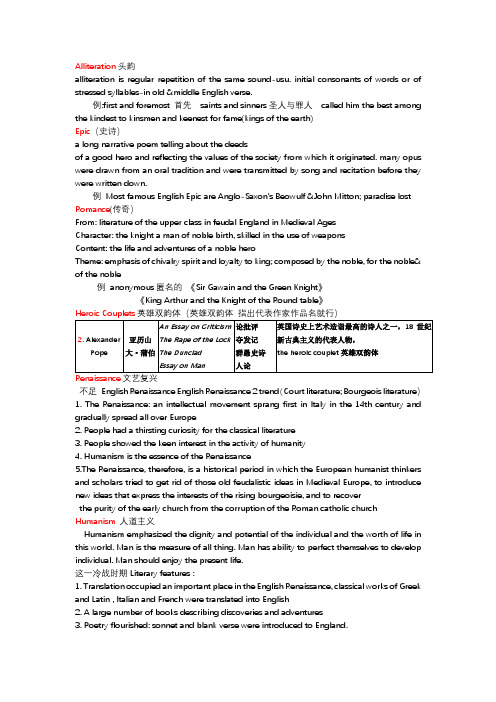
Alliteration头韵alliteration is regular repetition of the same sound-usu. initial consonants of words or of stressed syllables-in old &middle English verse.例:first and foremost 首先saints and sinners圣人与罪人called him the best among the kindest to kinsmen and keenest for fame(kings of the earth)Epic(史诗)a long narrative poem telling about the deedsof a good hero and reflecting the values of the society from which it originated. many opus were drawn from an oral tradition and were transmitted by song and recitation before they were written down.例Most famous English Epic are Anglo-Saxon's Beowulf &John Mitton; paradise lost Romance(传奇)From: literature of the upper class in feudal England in Medieval AgesCharacter: the knight a man of noble birth, skilled in the use of weaponsContent: the life and adventures of a noble heroTheme: emphasis of chivalry spirit and loyalty to king; composed by the noble, for the noble& of the noble例anonymous匿名的《Sir Gawain and the Green Knight》《King Arthur and the Knight of the Round table》Heroic Couplets英雄双韵体(英雄双韵体指出代表作家作品名就行)Renaissance文艺复兴不足English Renaissance English Renaissance 2 trend (Court literature; Bourgeois literature)1. The Renaissance: an intellectual movement sprang first in Italy in the 14th century and gradually spread all over Europe2. People had a thirsting curiosity for the classical literature3. People showed the keen interest in the activity of humanity4. Humanism is the essence of the Renaissance5.The Renaissance, therefore, is a historical period in which the European humanist thinkers and scholars tried to get rid of those old feudalistic ideas in Medieval Europe, to introduce new ideas that express the interests of the rising bourgeoisie, and to recover the purity of the early church from the corruption of the Roman catholic church Humanism人道主义Humanism emphasized the dignity and potential of the individual and the worth of life in this world. Man is the measure of all thing. Man has ability to perfect themselves to develop individual. Man should enjoy the present life.这一冷战时期Literary features :1. Translation occupied an important place in the English Renaissance, classical works of Greek and Latin , Italian and French were translated into English2. A large number of books describing discoveries and adventures3. Poetry flourished: sonnet and blank verse were introduced to England.4. The highest glory of the English Renaissance is dramaEssay 散文1. As a literary term, essay is used to cover an enormous range of composition, it could bea fairly short prose; in style often familiarly conversational and in subject either sect-revelatory or illustrative of social manners.2. Essay expounds an opinion, a judgment or an experience in a free style, but careful and precise in language and subtle and profound in meaning.Drama戏剧the form of composition designed for performance in the theatre, in which actors take the roles of the characters, perform the indicated action and utter thewritten dialogue. (The common alternative name for a dramatic composition is a play) Three main types : a Miracle Play 奇迹剧; Morality play道德剧;Interlude 插剧English drama had its beginning with the church plays of the Middle AgeThe miracle plays are also called mystery plays. Content: Bible Features: Secular and humorous/comical; homely realismMorality play very much differs from the mystery play. It is an allegory in which abstract virtues and vices appear in personified form. A little after miracle plays, a morality presented the conflict of good and evil with allegorical personages, such as Mercy, Peace, Hate, FollyBlank Verse无韵体诗Blank verse refers to written in unrhymed iambic pentameter无韵的五步抑扬格Blank verse has been called the most " natural " verse form for dramatic works, since it supposedly is the verse form most close to natural rhythms of English speech.The passionate shepherd to his love (desire for love) It was extensively employed in English poetry of the Renaissance.Sonnet十四行诗Some is lyric poem in a single stanza consisting of 14 iambic petameter lines linked by an intricate rhyme scheme (韵式)The rhyme , in English , usually follows one of 2 main patterns :( 1 ) : The Italian or Petrarchan ( 彼得拉克式)sonnet(2) . The English sonnet or Shakespearean someComedy喜剧1. a play written chiefly to amuse its audience by a sense of superiority over the characters2. A comedy will normally be closer to everyday life than a tragedy, and will explore common human failings rather than tragedy's disastrous crimes3. Its ending will usually be happy for the leading characters.④Mature Period (1601-1607)Four great Tragedies:Hamlet, Othello; king Lear, MacbethTragedy悲剧1.serious play or novel representing the disastrous downfall of a central character the protagonist.2 The purpose is to achieve a crisis through incidents arousing pity and terror.3. The tragic effect usually depends on our awareness of admirable qualities in the protagonist, which are wasted terribly in the fated disaster.Allegory寓言1. A tale in verse or prose in which characters,actions, or settings represent abstract ideas or moral qualities,thus; an allegory is a story with two meanings, a literal meaning and a symbol meaning.2. Its central device is the personification of abstract entities such us vice, state of mind3. The most famous allegory in English literature is Ton Bunyan's The Pilgrim's Progress. The Enlightenment启蒙运动1. An intellectual movement in the 18th century, beginning in France and then spread throughout Europe.2.On the whole it was an expression of struggle of the progressive class of bourgeoisie against the feudalism.3. It was a continuation of Renaissance in belief in the possibility of human perfection through education.4. Rationality, reason, natural right and equality became standard for measurement of everything.Neoclassicism 新古典主义1.The Benightment Movement brought about a revival of interest in the old classical works, this tendency is known as neoclassicism2. The neoclassicists held that forms of literature were to be modeled after the classical works of the ancient Greek and Roman writers,such as Homer3.Pope,Addison, Steele belonged to this trend ...Mock Epic讽刺史诗Mock epic is a satiric literacy form that treats a trivial or commonplace subject with the elevated language and heroic style of the classical epicSatire讽刺文学(1) Satire is the literary art ridiculing a folly or vice in order to expose or correct it.(2) It evokes attitudes of amusement, contempt, scorn, or indignation toward its faulty subject in the hope of somehow improving it.E.g.: Jonathan Swift, Alexander Pope, Samuel Johnson are all great satirists.Modern novel现代小说(1) Modern novel began in the 18th century and gave the world such novelists as Defoe, Richardson, Smollett and Sterne.(2) Daniel Robinson Crusoe was one of the forerunners of the English 18th century realistic novel.(3) But it was Henry Fielding and Tobias George Smollett who because the real founders of the genre of the bourgeois realistic novel in English and Europe.Sentimentalism伤感主义(1) Sentimentalism appeared in the middle of 18th century and marked the transition from classicism to romanticism.(2) It reacts against anything rational and advocates that sentiment should take the place of reason.(3) Thomas Gray, Oliver Goldsmith, Laurence Stern, Samuel Richardson arerepresentatives of this school.Elegy挽歌A lyric poem lamenting the death of an individual. It is usually formal in language and structure, and solemn or even melancholy in tone.E.g.: Elegy Written in a Country Churchyard墓园挽歌English Romanticism英国浪漫主义It is generally defined in 1798 with the publication of Wordsworth and Coleridge’s “Lyrical Ballads” and end in 1832 with Sir Walter Scott’s death and the passage of the first Reform Bill in the Parliament.Characteristics: 1. Imagination 2. worship of nature 3. symbolism and myth4. simplicity and humanity5. spontaneity(自发性)Byronic Hero(拜伦式英雄)Typical Byronic hero: Childe Harold; Don Juan(1) A proud revolutionary figure of noble origin(2) Fiery passion; unbending will.(3) Ideal of freedom(4) Against tyranny and injustice(5) Lonely fighters, individualistic endsOde颂歌a lyric poem of some length, dealing with a lofty(高尚的theme in a dignified manner and originally intended to be sung.e.g.: Ode to the West WindEnglish Critical Realism英国批判现实主义(1) English critical realism flourished in the 40s and the early 50s(2) The critical realists described with much vividness and artistic skill the chief traits of the English society and criticized the capitalist System from a democratic viewpoint. They focused on the Dark Side of the society.(3) Critical realists revealed the social reality and criticized the injustice, poverty and religious hypocrisy.Features of Critical Realism批判现实主义的特点(1) The realists first and foremost criticized the capitalist society and portrayed the crying contradiction of bourgeois reality.(2) The greatness of the English realists lies not only in their satirical portrayal of bourgeoisie and in the exposure of the greed and hypocrisy of the ruling classes, but also in their sympathy for the laboring people.(3) Humor and satire are used to expose and criticize the dark side of the reality.(4) The major contribution of the critical realists lies in their perfection of the novel.The 19th century realistic novels become “the epic of the bourgeois society”Gothic Novel(哥特式小说)(1) It is a type of romantic fiction that predominated the late 18th century.(2) Its principal elements are: violence, horror and supernatural.(3) It focusses on the description of the dark, irrational side of the human nature. Dramatic monologue(戏剧独白诗)Dramatic Monologue refers to a lyric poem inwhich a speaker addresses himself to one or severallisteners who don't reply. Such poems reveal not thepoet's own thoughts but the mind of the impersonatedcharacter, whose personality is revealed unwittingly." My Last Duchess " is his best-known dramatic monologue.Aestheticism唯美主义1. Aestheticism is the doctrine or disposition that regards beauty as an end in itself, and attempts to (preserve the art from subordination to didactic, or political purposes?2. The team is often used synonymously with the Aesthetic Movement, a literary and artistic tendency, of the late 19th century which maybe understood as a further phase of Romanticism in the reaction against philistine bourgeois values of practical efficiency andmorality.3. Aestheticism separated the sense of beauty from practical interest. Its slogan is art for art's sake.4. It was a kind of escapism in essence.5. Aestheticism was one of the reactions against the Victorian convention of art for morality’ssake, or art for money's sake.6. Water Pater and Oscar WildeNaturalism自然主义1. Influenced by Darwin's The Origin of Species and the idea of " survival of the fittest “, Hardly believes that man's fate is predeterminedtragic, driven by a combined force of "nature “, both inside and outside.(2) The Outside nature - the natural environment or Nature itself is shown as some mysterious supernatural force, very powerful buthare-brained, impulsive and uncaring to the individual's will,hope, passion or suffering. (3) Man proves impotent before Fate;however, he tries, and he seldom escapes his ordained destiny.Psychological Fiction心理小说1.Modernist fiction put emphasis on the description of the character's psychologicalactivities, and so has been called modern psychological fiction.George Eliot乔治·艾略特《The Mill on the Floss》弗罗斯河上的磨房,9世纪现实主义小说的真正代表,心理小说的先驱Modernism现代主义1. The movement known as English literary modernism grew out of a general sense of disillusionment with Victorian era attitudes of certainty, conservation and objective truth.2. Literary modernism reached its peak betweenthe First and Second World Wars. Characteristics of modernismModernism marks a strong &conscious break with the pastModernism rose out of the skepticism and disillusion of capitalism。
Gothic Novel
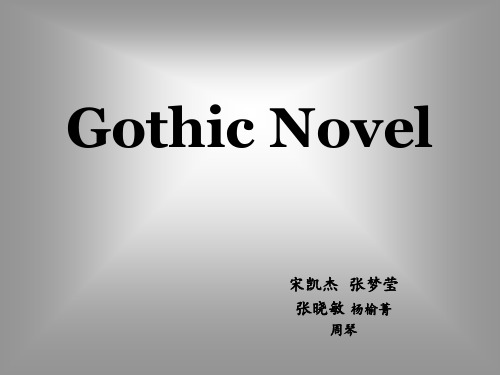
Intro. of The Castle of Otranto
First published in 1764, The Castle of Otranto purported to be a translation of an Italian story of the time of the crusades(十字军东 征). In it Walpole attempted, as he declared in the Preface to the Second Edition, "to blend the two kinds of romance: the ancient and the modern." Crammed with invention, entertainment, terror, and pathos, the novel was an immediate success and Walpole's own favorite among his numerous works. The novel is reprinted here from a text of 1798, the last that Walpole himself prepared for the press.
Two Branches
• One is horrible Gothic Novels. • Features: This branch of gothic novels insist on traditional ways. Morbid evil are added in order to make the novel more mysterious and horrible. • Representative: • Matthew Lewis (1775-1818), The Monk (1795) • Charles Brown,1771-1810), Wieland (1798)
小说种类中英对照
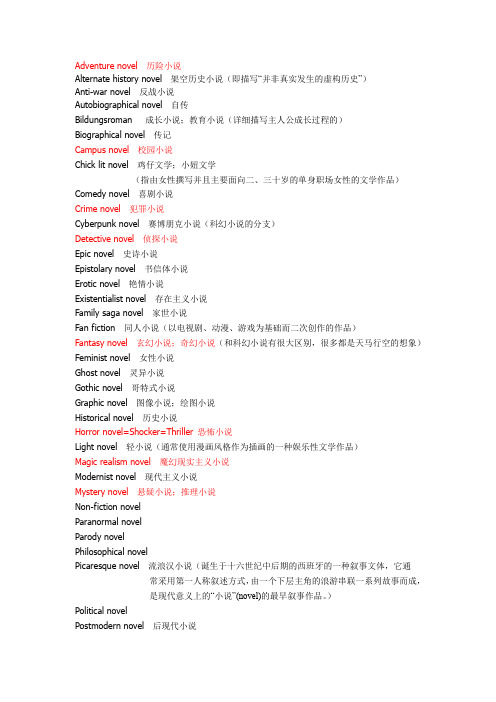
Adventure novel 历险小说Alternate history novel 架空历史小说(即描写“并非真实发生的虚构历史”)Anti-war novel 反战小说Autobiographical novel 自传Bildungsroman 成长小说;教育小说(详细描写主人公成长过程的)Biographical novel 传记Campus novel 校园小说Chick lit novel 鸡仔文学;小妞文学(指由女性撰写并且主要面向二、三十岁的单身职场女性的文学作品)Comedy novel 喜剧小说Crime novel 犯罪小说Cyberpunk novel 赛博朋克小说(科幻小说的分支)Detective novel 侦探小说Epic novel 史诗小说Epistolary novel 书信体小说Erotic novel 艳情小说Existentialist novel 存在主义小说Family saga novel 家世小说Fan fiction 同人小说(以电视剧、动漫、游戏为基础而二次创作的作品)Fantasy novel 玄幻小说;奇幻小说(和科幻小说有很大区别,很多都是天马行空的想象)Feminist novel 女性小说Ghost novel 灵异小说Gothic novel 哥特式小说Graphic novel 图像小说;绘图小说Historical novel 历史小说Horror novel=Shocker=Thriller 恐怖小说Light novel 轻小说(通常使用漫画风格作为插画的一种娱乐性文学作品)Magic realism novel 魔幻现实主义小说Modernist novel 现代主义小说Mystery novel 悬疑小说;推理小说Non-fiction novelParanormal novelParody novelPhilosophical novelPicaresque novel 流浪汉小说(诞生于十六世纪中后期的西班牙的一种叙事文体,它通常采用第一人称叙述方式,由一个下层主角的浪游串联一系列故事而成,是现代意义上的“小说”(novel)的最早叙事作品。
Gothic-novel哥特式小说(英文)PPT课件

5. Supernatural(超自然的) or otherwise inexplicable(莫名其妙的) events. Dramatic,
amazing events occur, such as ghosts or giants walking, or inanimate objects (such as a suit of armor or painting) coming to life. In some works, the events are ultimately given a natural explanation, while in others the events are truly supernatural.
7
3. An ancient prophecy(预言) is connected with the castle or its inhabitants (either former or present). The
prophecy is usually obscure, partial, or confusing. "What could it mean?" In more watered down modern examples, this may amount to merely a legend: "It's said that the ghost of old man Krebs still wanders these halls."
着霍勒斯·沃波尔的《奥特兰托城堡》而产
生。哥特小说可以说是恐怖电影的鼻祖,更
重要的是,它使我们今天习惯地将哥特式与
黑暗、恐怖联系在一起。 显著的哥特小说元
美国哥特式介绍

Gothic渊源和特征早期美国通俗小说的第三道风景线为哥特式小说(gothic fiction)。
“哥特式”(gothic)这个词在英语里有多种含义。
它既是一个文学词汇,又是一个历史术语,还可以用作建筑和艺术方面的专门用语。
作为一个文学词汇,它也有多种含义。
它既指一种文学现象,又指一类文学作品,还可以表示一种文学创作方法;而且在不同的历史时期和历史阶段,这些文学现象、文学作品、文学创作方法的内涵也不尽相同。
此处按照通常的做法,用它来表示一类通俗小说。
这类小说曾经在18世纪末和19世纪初十分繁荣,然而它们的作者,除少数外,均被文学批评家和文学史家所忽视。
其模式特征是,故事常常发生在遥远的年代和荒僻的地方,人物被囚禁在狭窄的空间和鬼魂出没的建筑内,悬疑和爱情交织在一起。
惯常的悬疑手段有神秘的继承权、隐秘的身世、丢失的遗嘱、家族的秘密、祖传的诅咒,等等。
到最后,悬疑解开,歹徒暴露,男女主人公的爱情障碍扫除。
不过,这种爱情有别于言情小说里的爱情。
两者的区别是:哥特式小说通常描写神秘冒险故事,其爱情障碍往往来自歹徒;而言情小说描写家庭平凡琐事,其爱情障碍往往来自男女主人公本身。
哥特式小说起源于18世纪后期的英国,开山鼻祖是霍勒斯·沃波尔。
他的《奥特兰托城堡》创立了早期古典哥特式小说的模式。
哥特式小说的出现,既与当时英国墓园派诗人的“哥特式”情结有关,也与埃德蒙·伯克(Edmund Burke,1729—1797)的“哥特式”美学标准有联系。
此外,它还借鉴了理查森的《克拉丽莎》的“女郎一恶棍”这一对立模式。
这种小说问世不久,即引起克拉拉·里夫(Clara Reeve,1729—1807)、索菲娅·李(Sophia Lee,1750—1824)、威廉·贝克福德(William Beckford,1760—1844)等许多人仿效,成为最流行的体裁,并迅速从英国扩展到整个欧美。
英国文学复习资料
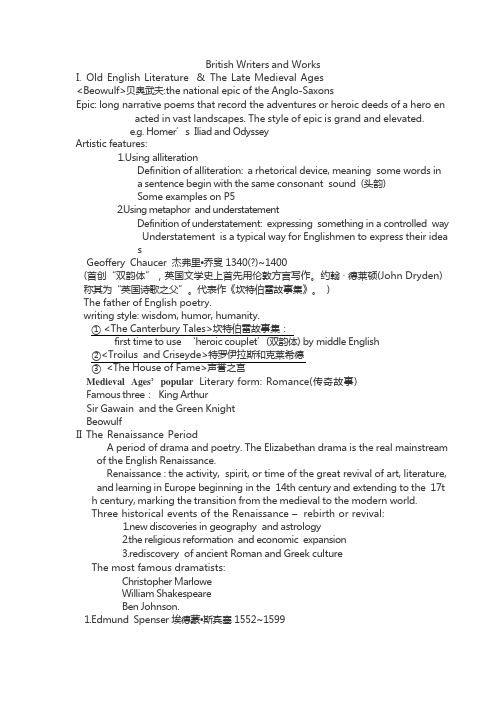
British Writers and WorksI. Old English Literature & The Late Medieval Ages<Beowulf>贝奥武夫:the national epic of the Anglo-SaxonsEpic: long narrative poems that record the adventures or heroic deeds of a hero en acted in vast landscapes. The style of epic is grand and elevated.e.g. Homer’s Iliad and OdysseyArtistic features:ing alliterationDefinition of alliteration: a rhetorical device, meaning some words ina sentence begin with the same consonant sound (头韵)Some examples on P5ing metaphor and understatementDefinition of understatement: expressing something in a controlled wayUnderstatement is a typical way for Englishmen to express their ideasGeoffery Chaucer 杰弗里•乔叟 1340(?)~1400(首创“双韵体”,英国文学史上首先用伦敦方言写作。
约翰· 德莱顿(John Dryden) 称其为“英国诗歌之父”。
代表作《坎特伯雷故事集》。
)The father of English poetry.writing style: wisdom, humor, humanity.① <The Canterbury Tale s>坎特伯雷故事集:first time to use ‘heroic couplet’(双韵体) by middle English②<Troilus and Criseyde>特罗伊拉斯和克莱希德③ <The House of Fame>声誉之宫Medieval Ages’popular Literary form: Romance(传奇故事)Famous three: King ArthurSir Gawain and the Green KnightBeowulfII The Renaissance PeriodA period of drama and poetry. The Elizabethan drama is the real mainstreamof the English Renaissance.Renaissance : the activity, spirit, or time of the great revival of art, literature, and learning in Europe beginning in the 14th century and extending to the 17th century, marking the transition from the medieval to the modern world.Three historical events of the Renaissance –rebirth or revival:1.new discoveries in geography and astrology2.the religious reformation and economic expansion3.rediscovery of ancient Roman and Greek cultureThe most famous dramatists:Christopher MarloweWilliam ShakespeareBen Johnson.1.Edmund Spenser 埃德蒙•斯宾塞 1552~1599(后人称之为“诗人的诗人”。
小说种类中英对照
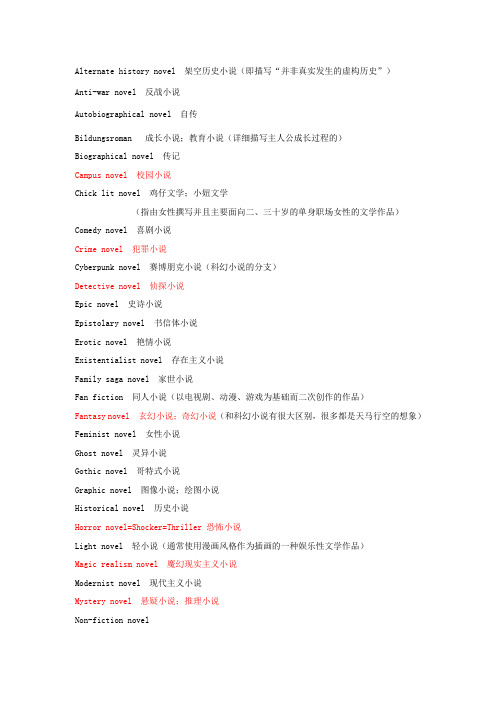
Alternate history novel 架空历史小说(即描写“并非真实发生的虚构历史”)Anti-war novel 反战小说Autobiographical novel 自传Bildungsroman 成长小说;教育小说(详细描写主人公成长过程的)Biographical novel 传记Campus novel 校园小说Chick lit novel 鸡仔文学;小妞文学(指由女性撰写并且主要面向二、三十岁的单身职场女性的文学作品)Comedy novel 喜剧小说Crime novel 犯罪小说Cyberpunk novel 赛博朋克小说(科幻小说的分支)Detective novel 侦探小说Epic novel 史诗小说Epistolary novel 书信体小说Erotic novel 艳情小说Existentialist novel 存在主义小说Family saga novel 家世小说Fan fiction 同人小说(以电视剧、动漫、游戏为基础而二次创作的作品)Fantasy novel 玄幻小说;奇幻小说(和科幻小说有很大区别,很多都是天马行空的想象)Feminist novel 女性小说Ghost novel 灵异小说Gothic novel 哥特式小说Graphic novel 图像小说;绘图小说Historical novel 历史小说Horror novel=Shocker=Thriller 恐怖小说Light novel 轻小说(通常使用漫画风格作为插画的一种娱乐性文学作品)Magic realism novel 魔幻现实主义小说Modernist novel 现代主义小说Mystery novel 悬疑小说;推理小说Non-fiction novelParanormal novelParody novelPhilosophical novelPicaresque novel 流浪汉小说(诞生于十六世纪中后期的西班牙的一种叙事文体,它通常采用第一人称叙述方式,由一个下层主角的浪游串联一系列故事而成,是现代意义上的“小说”(novel)的最早叙事作品。
Gothic novel哥特文学
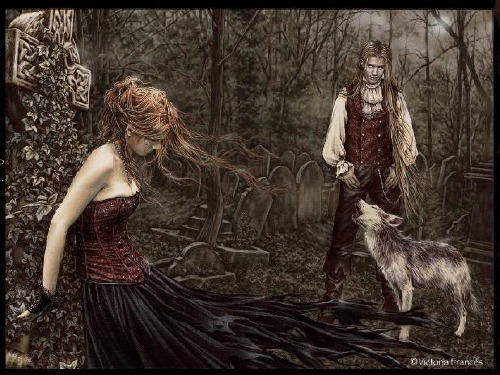
1、of the Goths (Germanic people who invaded
the Roman Empire); 2、 of or in a style common in W Europe from the 12th to the 16th centuries and characterized by pointed arches, arched roofs, tall thin pillars 3、of or in an 18th-century style of literature which described romantic adventures in mysterious or frightening settings
The basic plot :
a threatening mystery and an ancestral curse, as well as countless trappings such as hidden passages and oft-fainting heroines.
The romance, usually held in contempt by the educated as a tawdry and debased kind of writing, had only recently been made respectable by the works of Richardson and Fielding (Fuchs, 2004; 106). A romance with superstitious elements, and moreover void of didactical intention, was considered a setback and not acceptable as a modern production.
Gothic_novel哥特式小说(英文) 2 - 副本
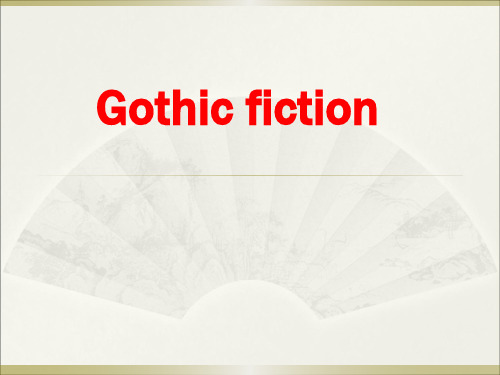
4. Omens, portents, visions(预兆). A character may have a disturbing dream vision, or some phenomenon may be seen as a portent of coming events. For example, if the statue of the lord of the manor falls over, it may portend his death. In modern fiction, a character might see something (a shadowy figure stabbing another shadowy figure) and think that it was a dream. This might be thought of as an "imitation vision."
The influence of Byronic Romanticism evident in Poe is also apparent in the work of the Brontë sisters. Emily Brontë Wuthering 's Heights (1847) transports the Gothic to the forbidding Yorkshire Moors and features ghostly apparitions
5. Supernatural(超自然的) or
otherwise inexplicable(莫名其妙的) events. Dramatic, amazing events
occur, such as ghosts or giants walking, or inanimate objects (such as a suit of armor or painting) coming to life. In some works, the events are ultimately given a natural explanation, while in others the events are truly supernatural.
英美文学史名词解释
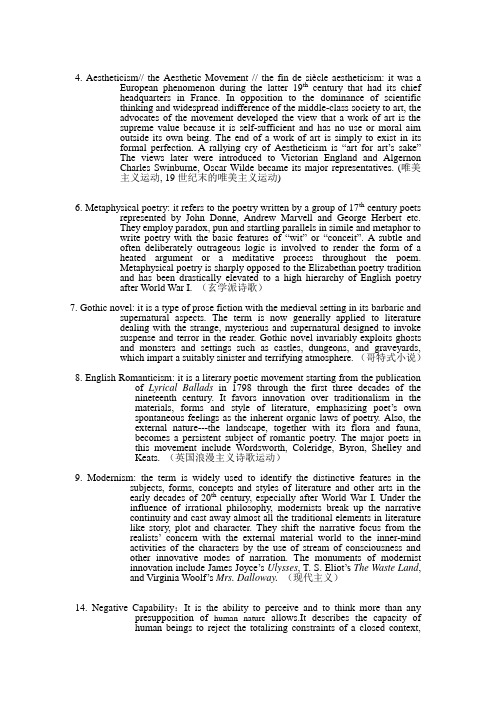
4. Aestheticism// the Aesthetic Movement // the fin de siècle aestheticism: it was aEuropean phenomenon during the latter 19th century that had its chiefheadquarters in France. In opposition to the dominance of scientificthinking and widespread indifference of the middle-class society to art, theadvocates of the movement developed the view that a work of art is thesupreme value because it is self-sufficient and has no use or moral aimoutside its own being. The end of a work of art is simply to exist in itsformal perfection. A rallying cry of Aestheticism is “art for art’s sake”The views later were introduced to Victorian England and AlgernonCharles Swinburne, Oscar Wilde became its major representatives. (唯美主义运动, 19世纪末的唯美主义运动)6. Metaphysical poetry: it refers to the poetry written by a group of 17th century poetsrepresented by John Donne, Andrew Marvell and George Herbert etc.They employ paradox, pun and startling parallels in simile and metaphor towrite poetry with the basic features of “wit”or “conceit”. A subtle andoften deliberately outrageous logic is involved to render the form of aheated argument or a meditative process throughout the poem.Metaphysical poetry is sharply opposed to the Elizabethan poetry traditionand has been drastically elevated to a high hierarchy of English poetryafter World War I. (玄学派诗歌)7. Gothic novel: it is a type of prose fiction with the medieval setting in its barbaric andsupernatural aspects. The term is now generally applied to literaturedealing with the strange, mysterious and supernatural designed to invokesuspense and terror in the reader. Gothic novel invariably exploits ghostsand monsters and settings such as castles, dungeons, and graveyards,which impart a suitably sinister and terrifying atmosphere. (哥特式小说)8. English Romanticism: it is a literary poetic movement starting from the publicationof Lyrical Ballads in 1798 through the first three decades of thenineteenth century. It favors innovation over traditionalism in thematerials, forms and style of literature, emphasizing poet’s ownspontaneous feelings as the inherent organic laws of poetry. Also, theexternal nature---the landscape, together with its flora and fauna,becomes a persistent subject of romantic poetry. The major poets inthis movement include Wordsworth, Coleridge, Byron, Shelley andKeats. (英国浪漫主义诗歌运动)9. Modernism: the term is widely used to identify the distinctive features in thesubjects, forms, concepts and styles of literature and other arts in theearly decades of 20th century, especially after World War I. Under theinfluence of irrational philosophy, modernists break up the narrativecontinuity and cast away almost all the traditional elements in literaturelike story, plot and character. They shift the narrative focus from therealists’concern with the external material world to the inner-mindactivities of the characters by the use of stream of consciousness andother innovative modes of narration. The monuments of modernistinnovation include James Joyce’s Ulysses, T. S. Eliot’s The Waste Land,and Virginia Woolf’s Mrs. Dalloway. (现代主义)14. Negative Capability:It is the ability to perceive and to think more than anypresupposition of human nature allows.It describes the capacity ofhuman beings to reject the totalizing constraints of a closed context,and to both experience phenomenon free from any epistemologicalbounds as well as to assert their own will and individuality upo n theiractivity. The term was first used by John Keats to critique those whosought to categorize all experience and phenomena and turn them intoa theory of knowledge. (济慈的消极感受能力,也可译为延疑力)17. Renaissance: the term, meaning “rebirth”, is commonly applied to the movementthat marks the transition from the medieval to the modern world inWestern Europe from 14th century to early 17th centuries. The peopleof the time turned to the treasures of classical writers and culture forinspiration. As a cultural movement, Renaissance encompassed aflowering of literature, science, art, religion, and politics, and aresurgence of learning based on classical sources, the development oflinear perspective in painting, and gradual but widespread educationalreform. Although the Renaissance saw revolutions in many intellectualpursuits, as well as social and political upheaval, it is perhaps bestknown for its artistic developments and the contributions of suchpolymaths as Leonardo da Vinci, Michelangelo and WilliamShakespeare. (文艺复兴)18. Sonnet: it is a lyric poem of 14 lines with a formal rhyme scheme, expressingdifferent aspects of a single thought, mood, or feeling, sometimesresolved or summed up in the last lines of the poem. The two mainforms of the sonnet are the Petrarchan, or Italian, and the English, orShakespearean. (十四行诗)19. Dramatic Monologue:a poem delivered in a dramatic manner by a single personaspeaker who is not identified with the poet usually to achieve an ironiceffect.20. Irony: The use of words to express something other than or opposite of theliterary meaning, so that a humorous or sardonic literary style or formis achieved.Authors and their Works2. William Shakespeare: Hamlet Act 3, Scene 1 and Sonnet 185. John Milton: Paradise Lost (Book 1, Lines 111-179)7. Jonathan Swift: Gulliver’s Travels (Chapter VII)12. William Wordsworth: The Daffodils (I Wandered Lonely as a Cloud)15. Percy Bysshe Shelley: Ode to the West Wind16. John Keats: Ode on a Grecian Urn18. Robert Browning: My Last Duchess19. Matthew Arnold: Dover Beach23. Charles Dickens: Great Expectations24. Thomas Hardy: Tess of the D’ Urbervilles26. James Joyce: Araby28. D. H. Lawrence: The Rocking Horse Winner。
英国文学简史术语解释总结(英文)整理版
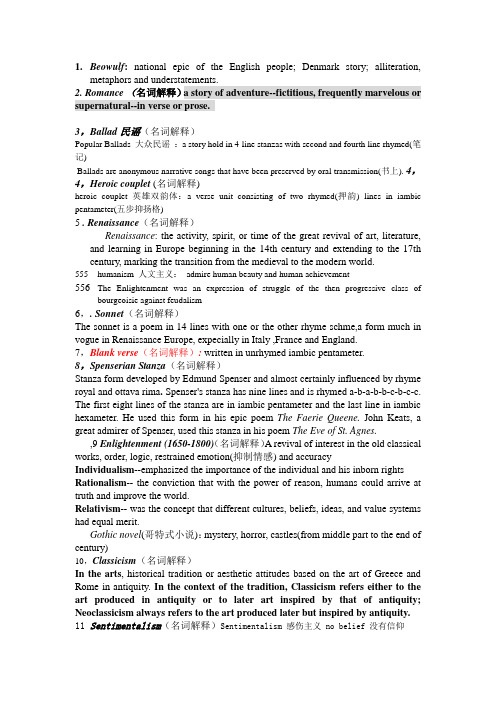
1.Beowulf: national epic of the English people; Denmark story; alliteration,metaphors and understatements.2. Romance (名词解释)a story of adventure--fictitious, frequently marvelous or supernatural--in verse or prose.3,Ballad民谣(名词解释)Popular Ballads 大众民谣:a story hold in 4-line stanzas with second and fourth line rhymed(笔记)Ballads are anonymous narrative songs that have been preserved by oral transmission(书上). 4,4,Heroic couplet (名词解释)heroic couplet 英雄双韵体:a verse unit consisting of two rhymed(押韵) lines in iambic pentameter(五步抑扬格)5 . Renaissance(名词解释)Renaissance: the activity, spirit, or time of the great revival of art, literature, and learning in Europe beginning in the 14th century and extending to the 17th century, marking the transition from the medieval to the modern world.555humanism 人文主义:admire human beauty and human achievement556The Enlightenment was an expression of struggle of the then progressive class of bourgeoisie against feudalism6,. Sonnet(名词解释)The sonnet is a poem in 14 lines with one or the other rhyme schme,a form much in vogue in Renaissance Europe, expecially in Italy ,France and England.7,Blank verse(名词解释): written in unrhymed iambic pentameter.8,Spenserian Stanza(名词解释)Stanza form developed by Edmund Spenser and almost certainly influenced by rhyme royal and ottava rima. Spenser's stanza has nine lines and is rhymed a-b-a-b-b-c-b-c-c. The first eight lines of the stanza are in iambic pentameter and the last line in iambic hexameter. He used this form in his epic poem The Faerie Queene. John Keats, a great admirer of Spenser, used this stanza in his poem The Eve of St. Agnes.,9 Enlightenment (1650-1800)(名词解释)A revival of interest in the old classical works, order, logic, restrained emotion(抑制情感) and accuracyIndividualism--emphasized the importance of the individual and his inborn rights Rationalism-- the conviction that with the power of reason, humans could arrive at truth and improve the world.Relativism-- was the concept that different cultures, beliefs, ideas, and value systems had equal merit.Gothic novel(哥特式小说):mystery, horror, castles(from middle part to the end of century)10,Classicism(名词解释)In the arts, historical tradition or aesthetic attitudes based on the art of Greece and Rome in antiquity. In the context of the tradition, Classicism refers either to the art produced in antiquity or to later art inspired by that of antiquity; Neoclassicism always refers to the art produced later but inspired by antiquity.11 Sentimentalism(名词解释)Sentimentalism 感伤主义 no belief 没有信仰The representatives of sentimentalism continued to struggle against feudalism but they vaguely sensed at the same time the contradictions of bourgeois progress that brought with it enslavement and ruin to the people.12 Graveyard School / Poets: A term applied to eighteenth-century poets who wrote meditative poems, usually set in a graveyard, on the theme of human mortality, in moods which range from elegiac pensiveness to profound gloom.13 Romanticism14 Lake Poets(名词解释)The Lake Poets all lived in the Lake District of England at the turn of the nineteenth century.15 Aestheticism唯美主义(名词解释)The Aesthetic Movement is a loosely defined movement in literature, fine art, the decorative arts, and interior design in later nineteenth-century Britain. It represents the same tendencies that symbolism or decadence stood for in France and may be considered the British branch of the same movement. It belongs to the anti-Victorian reaction and had post-Romantic roots, and as such anticipates modernism. It took place in the late Victorian period from around 1868 to 1901, and is generally considered to have ended with the trial of Oscar Wilde.16 Stream-of-consciousness(名词解释)The “stream of consciousness”is a psychological term indicating “the flux of conscious and subconscious thoughts and impressions moving in the mind at any given time independently of the person’s will”.。
the gothic novel 名词解释

名词解释:哥特小说
哥特小说是一种文学流派,起源于18世纪末的英国。
它以其独特的风格和主题而闻名,通常涉及令人毛骨悚然的情节、神秘的氛围和超自然元素。
这些小说的特点是以恐怖、罪恶、死亡和超自然现象为中心,同时也探索人类的内心世界和情感。
哥特小说的主题经常涉及到古老的城堡、幽暗的地下室、荒凉的墓地以及其他令人毛骨悚然的地点。
这些场景通常被用来传达一种不安全和不稳定的感觉,让读者感受到恐惧和紧张。
常见的情节包括幽灵、诅咒、疯狂科学家、吸血鬼和僵尸等超自然元素。
哥特小说的角色通常是痛苦的、受折磨的个体,他们经历了各种恐怖的事件和心理折磨。
这些角色往往具有复杂的内心世界,他们的内心和外貌之间存在冲突和对立。
他们的冲突通常来自于他们对社会规范的反叛和对禁忌的探索。
哥特小说的语言风格通常是华丽、诗意和描述性的,以强调情感和情绪。
作家经常使用象征和隐喻来传达主题和情节,使读者陷入一种悬疑和恐怖的氛围中。
此外,哥特小说还经常探索人类对死亡和永恒的恐惧,以及个体与社会之间的冲突。
哥特小说在文学史上占据了重要的地位,对后来的恐怖小说和奇幻小说产生了深远影响。
它不仅仅是一种娱乐形式,更是一个反映社会和文化背景的载体。
通过揭示人性的黑暗面和对超自然的探索,哥特小说提醒我们人类内心的复杂性和对未知的恐惧。
总而言之,哥特小说是一种以恐怖、罪恶和超自然元素为特征的文学流派。
它通过独特的风格和主题描绘了人类内心的黑暗面,同时也探索了个体与社会之间的冲突。
哥特小说的影响延续至今,成为了文学史上不可忽视的一部分。
英国文学名词解释
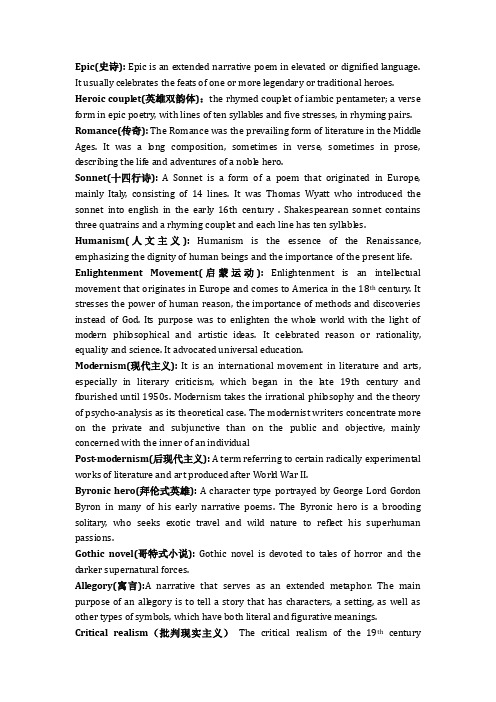
Epic(史诗): Epic is an extend ed narrative poem in elevated or dignified language. It usually celebrates the feats of one or more legendary or traditional heroes. Heroic couplet(英雄双韵体):the rhymed coupl et of iambic pentameter; a verse form in epic poetry, with lines of ten syllabl es and five stresses, in rhyming pairs. Romance(传奇): The Romance was the prevailing form of literature in the Mid dl e Ages. It was a l ong composition, sometimes in verse, sometimes in prose, d escribing the life and adventures of a nobl e hero.Sonnet(十四行诗):A Sonnet is a form of a poem that originated in Europe, mainly Italy, consisting of 14 lines. It was Thomas Wyatt who introduced the sonnet into english in the early 16th century . Shakespearean sonnet contains three quatrains and a rhyming couplet and each line has ten syllabl es. Humanism(人文主义): Humanism is the essence of the Renaissance, emphasizing the dignity of human beings and the importance of the present life. Enlightenment Movement(启蒙运动):Enlightenment is an intellectual movement that originates in Europe and comes to America in the 18th century. It stresses the power of human reason, the importance of methods and discoveries instead of God. Its purpose was to enlighten the whol e world with the light of mod ern phil osophical and artistic id eas. It celebrated reason or rationality, equality and science. It advocated universal education.Modernism(现代主义):It is an international movement in literature and arts, especially in literary criticism, which began in the late 19th century and fl ourished until 1950s. Mod ernism takes the irrational phil osophy and the theory of psycho-analysis as its theoretical case. The mod ernist writers concentrate more on the private and subjunctive than on the public and objective, mainly concerned with the inner of an individualPost-modernism(后现代主义): A term referring to certain radically experimental works of literature and art produced after World War II.Byronic hero(拜伦式英雄): A character type portrayed by George Lord Gord on Byron in many of his early narrative poems. The Byronic hero is a brooding solitary, who seeks exotic travel and wild nature to refl ect his superhuman passions.Gothic novel(哥特式小说): Gothic novel is d evoted to tales of horror and the darker supernatural forces.Allegory(寓言):A narrative that serves as an extend ed metaphor. The main purpose of an all egory is to tell a story that has characters, a setting, as well as other types of symbols, which have both literal and figurative meanings.Critical realism(批判现实主义)The critical realism of the 19th centuryfl ourished in the forties and in the beginning of fifties. The realists first and foremost set themselves the task of criticizing capitalist society form a d emocratic viewpoint and d elineated the crying contradictions of bourgeois reality. But they did not find a way to eradicate social evils.Metaphysical poetry(玄学派诗歌)It typically empl oys unusual verse forms, compl ex figures of speech applied to elaborate and surprising metaphorical conceits, and l earned themes discussed according to eccentric and expected chains of reasoning. As the l eading figure of the “metaphysical poetry”, Donne’s poetry exhibits each of these characteristics.A Valediction: forbidding Mourning" by John DonneAs virtuous men pass mildly away,正如德高人逝世很安然,And whisper to their souls, to go,对灵魂轻轻的说一声走,Whilst some of their sad friends do say,悲伤的朋友们聚在旁边,‘The breath goes now,’ and some say, ‘No:’有的说断气了,有的说没有。
frankenstein英文版
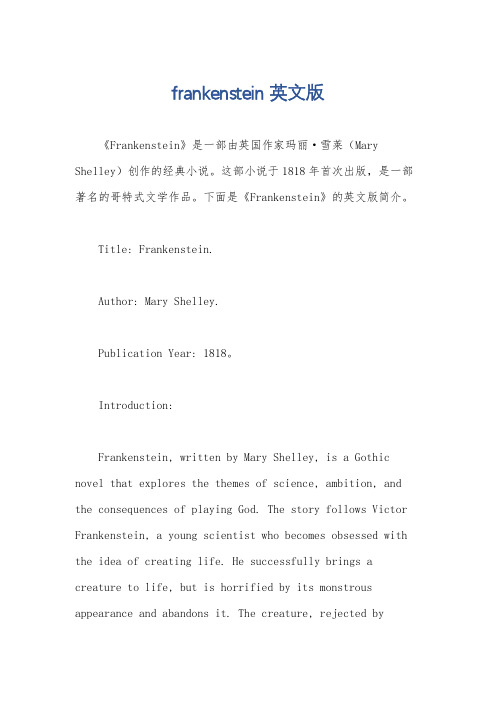
frankenstein英文版《Frankenstein》是一部由英国作家玛丽·雪莱(Mary Shelley)创作的经典小说。
这部小说于1818年首次出版,是一部著名的哥特式文学作品。
下面是《Frankenstein》的英文版简介。
Title: Frankenstein.Author: Mary Shelley.Publication Year: 1818。
Introduction:Frankenstein, written by Mary Shelley, is a Gothic novel that explores the themes of science, ambition, and the consequences of playing God. The story follows Victor Frankenstein, a young scientist who becomes obsessed with the idea of creating life. He successfully brings a creature to life, but is horrified by its monstrous appearance and abandons it. The creature, rejected bysociety, seeks revenge on its creator, leading to a tragic series of events.Summary:The novel begins with Captain Robert Walton's letters to his sister, detailing his journey to the North Pole. During his expedition, Walton encounters Victor Frankenstein, who shares his life story. Victor reveals his childhood, education, and his fascination with science, which ultimately leads him to create the creature.Victor's experiment is a success, but he is immediately repulsed by the creature's appearance and flees. The creature, left alone and rejected, struggles to find acceptance in society. It learns to read and speak, becoming increasingly intelligent and self-aware. The creature eventually confronts Victor, demanding that he create a companion for him, promising to leave society forever if his request is fulfilled.Victor initially agrees, but after contemplating thepotential consequences, he destroys the second creature before completing it. The enraged creature vows revenge and begins to kill those close to Victor. The two engage in a deadly pursuit across Europe, leading to the deaths of Victor's loved ones.In the end, Victor dies from exhaustion and illness, but not before expressing remorse for his actions. The creature, devastated by its creator's death, mourns over Victor's body and vows to end its own life. The novel concludes with Captain Walton's final letters, reflecting on the moral lessons learned from Victor's tragic tale.Themes:1. Ambition and the pursuit of knowledge: The novel explores the dangers of unchecked ambition and the consequences of pushing the boundaries of science.2. Nature versus nurture: The creature's actions raise questions about the influence of society and upbringing on an individual's behavior.3. Isolation and loneliness: Both Victor and the creature experience profound loneliness and isolation, highlighting the human need for companionship and acceptance.4. Responsibility and accountability: Victor grapples with the moral and ethical implications of his creation, raising questions about the responsibility of scientists and the consequences of their actions.Impact and Legacy:Frankenstein has had a significant impact on literature and popular culture. It is considered one of the earliest examples of science fiction and has inspired numerous adaptations in film, theater, and other forms of media. The novel's exploration of ethical and moral dilemmas continues to resonate with readers, making it a timeless and thought-provoking work.总结:《Frankenstein》是玛丽·雪莱创作的一部哥特式小说,探讨了科学、野心以及玩弄上帝力量的后果等主题。
英美文学
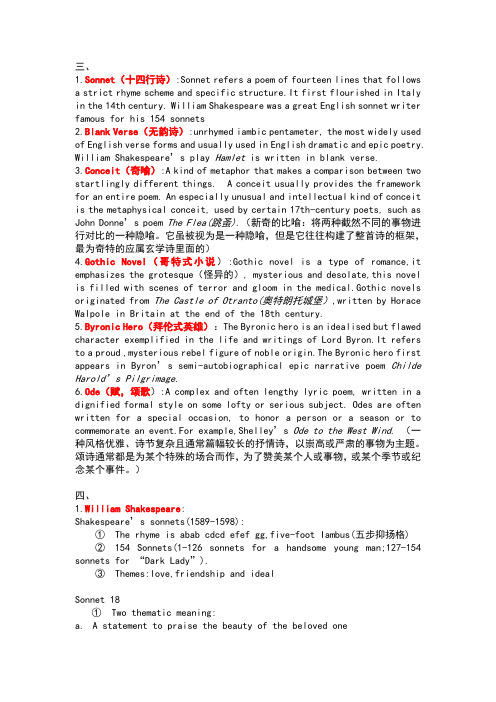
三、1.Sonnet(十四行诗):Sonnet refers a poem of fourteen lines that followsa strict rhyme scheme and specific structure.It first flourished in Italy in the 14th century. William Shakespeare was a great English sonnet writer famous for his 154 sonnets2.Blank Verse(无韵诗):unrhymed iambic pentameter, the most widely used of English verse forms and usually used in English dramatic and epic poetry. William Shakespeare’s play Hamlet is written in blank verse.3.Conceit(奇喻):A kind of metaphor that makes a comparison between two startlingly different things. A conceit usually provides the framework for an entire poem. An especially unusual and intellectual kind of conceit is the metaphysical conceit, used by certain 17th-century poets, such as John Donne’s poem The Flea(跳蚤).(新奇的比喻:将两种截然不同的事物进行对比的一种隐喻。
它虽被视为是一种隐喻,但是它往往构建了整首诗的框架,最为奇特的应属玄学诗里面的)4.Gothic Novel(哥特式小说):Gothic novel is a type of romance,it emphasizes the grotesque(怪异的), mysterious and desolate,this novel is filled with scenes of terror and gloom in the medical.Gothic novels originated from The Castle of Otranto(奥特朗托城堡),written by Horace Walpole in Britain at the end of the 18th century.5.Byronic Hero(拜伦式英雄):The Byronic hero is an idealised but flawed character exemplified in the life and writings of Lord Byron.It refers to a proud ,mysterious rebel figure of noble origin.The Byronic hero first appears in Byron’s semi-autobiographical epic narrative poem Childe Harold’s Pilgrimage.6.Ode(赋,颂歌):A complex and often lengthy lyric poem, written in a dignified formal style on some lofty or serious subject. Odes are often written for a special occasion, to honor a person or a season or to commemorate an event.For example,Shelley’s Ode to the West Wind. (一种风格优雅、诗节复杂且通常篇幅较长的抒情诗,以崇高或严肃的事物为主题。
英国文学哥特式小说
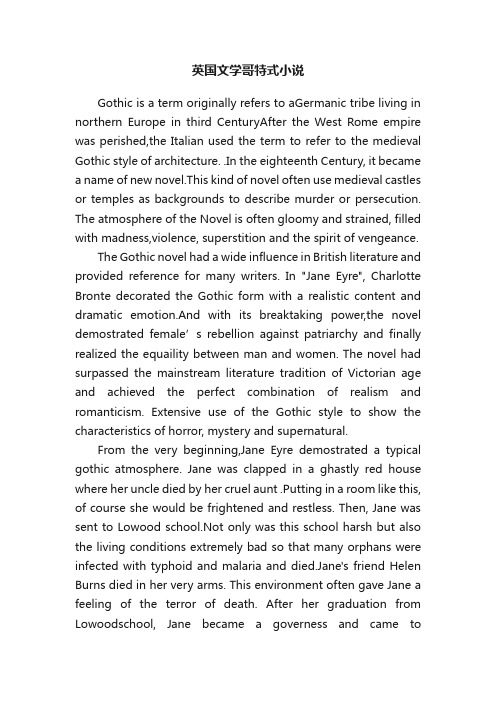
英国文学哥特式小说Gothic is a term originally refers to aGermanic tribe living in northern Europe in third CenturyAfter the West Rome empire was perished,the Italian used the term to refer to the medieval Gothic style of architecture. .In the eighteenth Century, it became a name of new novel.This kind of novel often use medieval castles or temples as backgrounds to describe murder or persecution. The atmosphere of the Novel is often gloomy and strained, filled with madness,violence, superstition and the spirit of vengeance.The Gothic novel had a wide influence in British literature and provided reference for many writers. In "Jane Eyre", Charlotte Bronte decorated the Gothic form with a realistic content and dramatic emotion.And with its breaktaking power,the novel demostrated female’s rebellion against patriarchy and finally realized the equaility between man and women. The novel had surpassed the mainstream literature tradition of Victorian age and achieved the perfect combination of realism and romanticism. Extensive use of the Gothic style to show the characteristics of horror, mystery and supernatural.From the very beginning,Jane Eyre demostrated a typical gothic atmosphere. Jane was clapped in a ghastly red house where her uncle died by her cruel aunt .Putting in a room like this, of course she would be frightened and restless. Then, Jane was sent to Lowood school.Not only was this school harsh but also the living conditions extremely bad so that many orphans were infected with typhoid and malaria and died.Jane's friend Helen Burns died in her very arms. This environment often gave Jane a feeling of the terror of death. After her graduation from Lowoodschool, Jane became a governess and came toThornfield .It was an old castle and its typical Gothic environment fashioned an atmosphere of terror and mysterious. Firstly the strange laughter in the attic ,then Rochester’s room caught fire in the middle of a night, and Mason’s brother was badly b itten in the midnight , all of which makes Jane feels the gloomy and horror of Thornfield. In addition to that, the main character Rochester in the novel also has a Gothic style. Rochester is not handsome: he was of medium height, broad chest,black face , thick eyebrows with a broad forehead.In the first place,Jane thought Rochester is a mysterious, cold, harsh man, too profound to be understood. Charlotte’s description of Rochester accord with Gothic style.。
哥特文学的名词解释英文
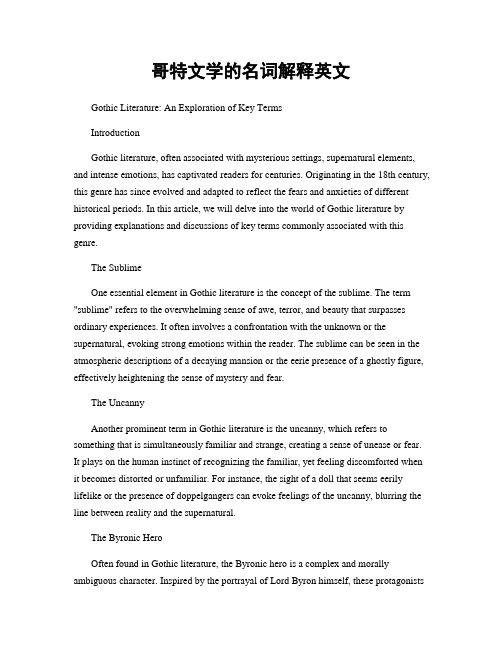
哥特文学的名词解释英文Gothic Literature: An Exploration of Key TermsIntroductionGothic literature, often associated with mysterious settings, supernatural elements, and intense emotions, has captivated readers for centuries. Originating in the 18th century, this genre has since evolved and adapted to reflect the fears and anxieties of different historical periods. In this article, we will delve into the world of Gothic literature by providing explanations and discussions of key terms commonly associated with this genre.The SublimeOne essential element in Gothic literature is the concept of the sublime. The term "sublime" refers to the overwhelming sense of awe, terror, and beauty that surpasses ordinary experiences. It often involves a confrontation with the unknown or the supernatural, evoking strong emotions within the reader. The sublime can be seen in the atmospheric descriptions of a decaying mansion or the eerie presence of a ghostly figure, effectively heightening the sense of mystery and fear.The UncannyAnother prominent term in Gothic literature is the uncanny, which refers to something that is simultaneously familiar and strange, creating a sense of unease or fear. It plays on the human instinct of recognizing the familiar, yet feeling discomforted when it becomes distorted or unfamiliar. For instance, the sight of a doll that seems eerily lifelike or the presence of doppelgangers can evoke feelings of the uncanny, blurring the line between reality and the supernatural.The Byronic HeroOften found in Gothic literature, the Byronic hero is a complex and morally ambiguous character. Inspired by the portrayal of Lord Byron himself, these protagonistspossess a troubled past, intense emotions, and often exhibit characteristics of rebellion or isolation. They are captivating figures that often possess a dark allure, drawing the reader into their inner turmoil and making them question societal norms through their actions and beliefs.The Femme FataleThe femme fatale is a term used to describe a highly seductive and mysterious female character in Gothic literature. Often depicted as dangerous and treacherous, the femme fatale possesses an irresistible charm that leads to the downfall of the protagonist or other male characters in the story. With her allure and manipulation, she challenges traditional gender roles, exerting her power over others.The GrotesqueThe grotesque is an essential element in Gothic literature, referring to the fusion of the beautiful and the repulsive. It often involves physical deformities, horrifying events, or disturbing imagery that provoke feelings of discomfort. The grotesque can be seen in the portrayal of monstrous creatures or twisted characters, highlighting the darker aspects of humanity with a touch of otherworldliness.The Haunted HouseNo discussion of Gothic literature is complete without mentioning the haunted house. It serves as a physical embodiment of the uncanny and the sublime, representing a place where the past merges with the present. The haunted house often features decaying architecture, eerie noises, and a sense of foreboding, encapsulating the dark secrets and unresolved traumas of its inhabitants.ConclusionGothic literature, with its rich history and diverse themes, continues to capture the imagination of readers worldwide. Through the exploration of key terms such as the sublime, the uncanny, the Byronic hero, the femme fatale, the grotesque, and the haunted house, we gain a deeper understanding of the nuances and complexities within this genre.The interplay of these elements reflects both the fears and desires of society, while allowing us to explore the darker recesses of the human psyche.。
- 1、下载文档前请自行甄别文档内容的完整性,平台不提供额外的编辑、内容补充、找答案等附加服务。
- 2、"仅部分预览"的文档,不可在线预览部分如存在完整性等问题,可反馈申请退款(可完整预览的文档不适用该条件!)。
- 3、如文档侵犯您的权益,请联系客服反馈,我们会尽快为您处理(人工客服工作时间:9:00-18:30)。
哥特小说,属于英语文学派别,是西方通俗 文学中惊险神秘小说的一种。一般被认为随 着霍勒斯· 沃波尔的《奥特兰托城堡》而产生。 哥特小说可以说是恐怖电影的鼻祖,更重要 的是,它使我们今天习惯地将哥特式与黑暗、 恐怖联系在一起。 显著的哥特小说元素包括 恐怖,神秘,超自然,厄运,死亡,颓废, 住着幽灵的老房子,癫狂,家族诅咒等。
Gothic novel as one branch of the English literature and the father of horror movies origins from The Castle of Otranto(1764). More importantly, it leads habitually with darkness and horror. Gothic elements include horror, mystery, supernatural phenomenon, misfortune, death, haunted houses, and family curses.
4. Omens, portents, visions(预兆). A character may have a disturbing dream vision, or some phenomenon may be seen as a portent of coming events. For example, if the statue of the lord of the manor falls over, it may portend his death. In modern fiction, a character might see something (a shadowy figure stabbing another shadowy figure) and think that it was a dream. This might be thought of as an "imitation vision."
2. An atmosphere of mystery and suspense (悬念). The work is pervaded by a threatening feeling, a fear enhanced by the unknown. Often the plot itself is built around a mystery, such as unknown parentage, a disappearance, or some other inexplicable event. Elements 3, 4, and 5 below contribute to this atmosphere. (Again, in modern filmmaking, the inexplicable events are often murders.)
6. High, even overwrought(过度紧张) emotion. The narration may be highly sentimental, and the characters are often overcome by anger, sorrow, surprise, and especially, terror. Characters suffer from raw nerves and a feeling of impending doom. Crying and emotional speeches are frequent. Breathlessness and panic are common. In the filmed gothic, screaming is common.
作品
The Castle of Otranto (1764) by Horace Walpole (《奥 特朗托堡》,霍拉斯· 瓦尔波尔) The Mysteries of Udolpho (1794) by Ann Radcliffe (《乌尔多芙的秘密》,又译《乌尔多芙的神秘》,安· 拉德克里 夫) Caleb Williams (1794) by William Godwin Frankenstein (1818) by Mary Shelley (Full text at Wikisource) (《弗兰肯斯坦》,又译《活跳尸》《科学怪人》, 玛丽· 雪莱) The Vampyre (1819) by John William Polidori (《吸血 鬼》,约翰· 威廉姆· 坡利多里) The Fall of the House of Usher (1839) by Edgar Allan Poe (Full text at Wikisource) (《厄舍府的倒塌》,埃德 加· 爱伦· 坡) The Tell-Tale Heart (1843) by Edgar Allan Poe (Full text at Wikisource) (《泄密的心》,埃德加· 爱伦· 坡)
7. Women in distress(危险,困难). As an appeal to the pathos and sympathy of the reader, the female characters often face events that leave them fainting, terrified, screaming, and/or sobbing. A lonely, pensive, and oppressed heroine is often the central figure of the novel, so her sufferings are even more pronounced and the focus of attention. The women suffer all the more because they are often abandoned, left alone (either on purpose or by accident), and have no protector at times.
9. The metonymy(转喻) of gloom(阴暗, 忧郁) and horror(恐惧). Metonymy is a subtype of metaphor, in which something (like rain) is used to stand for something else (like sorrow). For example, the film industry likes to use metonymy as a quick shorthand, so we often notice that it is raining in funeral scenes. Note that the following metonymies for "doom and gloom" all suggest some element of mystery, danger, or the supernatural.
Gothic elements include the following:
1. Setting in a castle. The action takes place in and around an old castle, sometimes seemingly abandoned, sometimes occupied. The castle often contains secret passages, trap doors, secret rooms, dark or hidden staircases, and possibly ruined sections. The castle may be near or connected to caves, which lend their own haunting flavor with their branchings, claustrophobia, and mystery.
3. An ancient prophecy(预言) is
connected with the castle or its inhabitants (either former or present). The
prophecy is usually obscure, partial, or confusing. "What could it mean?" In more watered down modern examples, this may amount to merely a legend: "It's said that the ghost of old man Krebs still wanders these halls."
8. Women threatened by a powerful,
impulsive(冲动), tyrannical(专横) male.
One or more male characters has the power, as king, lord of the manor, father, or guardian, to demand that one or more of the female characters do something intolerable. The woman may be commanded to marry someone she does not love (it may even be the powerful male himself), or commit a crime.
5. Supernatural(超自然的) or otherwise inexplicable(莫名其妙的) events. Dramatic, amazing events occur, such as ghosts or giants walking, or inanimate objects (such as a suit of armor or painting) coming to life. In some works, the events are ultimately given a natural explanation, while in others the events are truly l.
